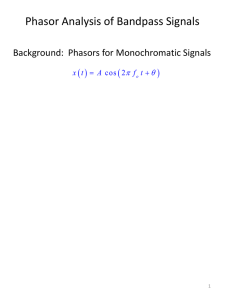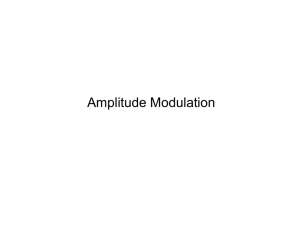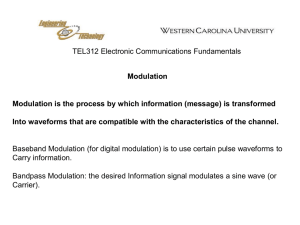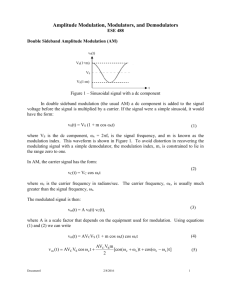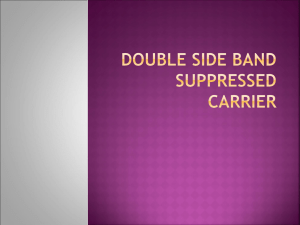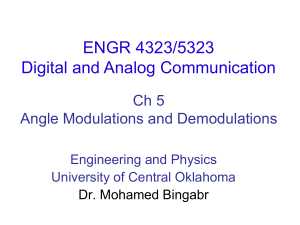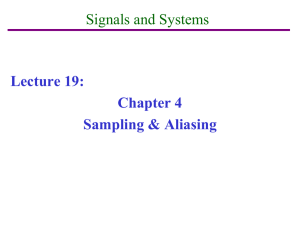ppt
advertisement
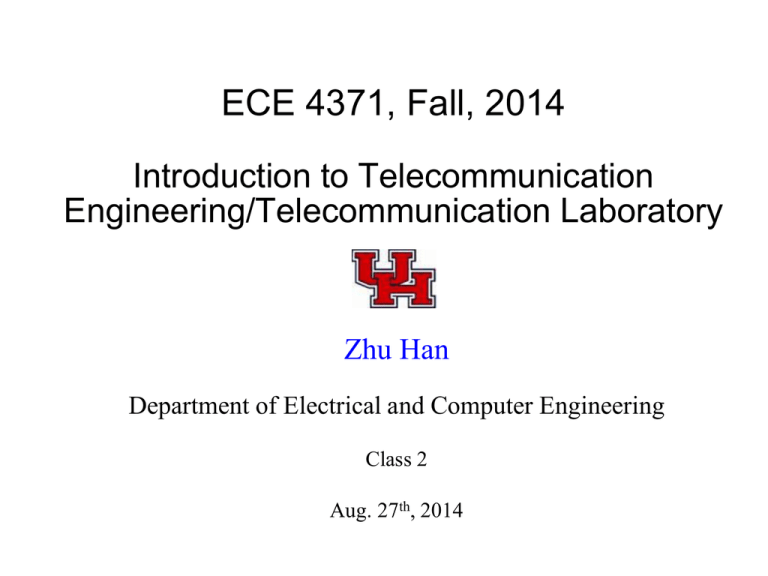
ECE 4371, Fall, 2014
Introduction to Telecommunication
Engineering/Telecommunication Laboratory
Zhu Han
Department of Electrical and Computer Engineering
Class 2
Aug. 27th, 2014
Overview
Chapter 4.1-4.3, basics of amplitude modulation
Other
– GPS
– Type of waves
– Satellite communication basics
Baseband and Carrier Communication
Baseband:
Describes signals and systems whose range of frequencies is measured
from 0 to a maximum bandwidth or highest signal frequency
Voice: Telephone 0-3.5KHz; CD 0-22.05KHz
Video: Analog TV 4.5MHz, TV channel is 0-6MHz. Digital, depending
on the size, movement, frames per second, …
Example: wire, coaxial cable, optical fiber, PCM phone
Carrier Communication:
Carrier: a waveform (usually sinusoidal) that is modulated to represent
the information to be transmitted. This carrier wave is usually of much
higher frequency than the modulating (baseband) signal.
Modulation: is the process of varying a carrier signal in order to use
that signal to convey information.
Example on the board.
Modulation
Modulation
A process that causes a shift in the range of frequencies of a signal.
Gain advantages
Antenna size: half of the antenna size. Thousands of miles for baseband
Better usage of limited bandwidth: less side lopes
Trade bandwidth for SNR: CDMA
Robust to inter-symbol-interference (multipath delay)
Robust to errors and distortions
Types
Analog: AM (DSB, SSB, VSB), FM, Delta modulation
Digital: ASK, FSK, PSK, QAM, …
Pulse modulation: PCM, PDM, … Fiber, phone
Advanced: CDMA (3G), OFDM (WLAN, WMAN), ….
Double Sideband
Modulation: m(t)cos(wct) 0.5[M(w-wc)+M(w+wc)]
Low/upper side band (LSB/USB), Double side band (DSB)
DSB-SC: suppressed carrier, no carrier frequency
Wc >= bandwidth of the signal to avoid aliasing.
Demodulation: e(t)=m(t)(cos(wct))^2=0.5(m(t)+m(t)cos(2wct))
E(w)=0.5M(w)+0.25(M(w+2wc)+M(w-2wc))
Low pass filter to remove the higher frequency
Coherent and non-coherent detection
– Receiver can recover the frequency and phase of the transmitter by
PLL. Error of timing can cause the performance error floor
– Non-coherent receiver has 3dB worst performance than coherent.
– Cheaper for Non-coherent receiver, Nextel.
AM-DSB-SC
Example 4.1
t
t
( t )
( t )
t
m( t )
cos( c t )
F{cos( c t )}
M( )
0
0
( )
c
0
Lower sideband (LSB)
c
c
Upper sideband (USB)
Categories of Modulators
Multiplier Modulators
– Multiply m(t) by cos(wct)
– Hard for linearity for high energy. Expensive. e.g. sound system
Nonlinear Modulators
– Example
Switching Modulators
– FFT transform to series of frequencies
– Series-bridge diode modulator, shunt-bridge diode modulator
– Ring Modulators
Frequency Conversion
Move the signals to other
frequency
Multiplying two sinusoids results
in two frequencies which are the
sum and difference of the
frequencies of the sinusoids
multiplied.
(t ) m(t ) cos(C t )
BPF@ I
cos(MIX t )
EXAMPLE : Let m(t)
be as shown.
m(t)
cos(t ) cos(t ) 21 [cos(( )t ) cos(( )t )]
To change the carrier frequency c
of a modulated signal to an
intermediate frequency I we use
an oscillator to generate a sinusoid
of frequency MIX such that
e1 (t ) 21 m(t ) cos(I t )
(t)
t
t
0
Example 4.2, 4.3
()
c
c
0
Then m(t)cos( c t ) cos(MIX t ) 21 m( t )[cos(( c MIX )t ) cos(( c MIX )t )]
21 m( t )[cos((2 c I )t ) cos((I )t )]
t
M()
SPECTRA
I c MIX .
e1(t)
E 1 ( )
I
0
I
Amplitude Modulation
Why DSB-SC not working: do not know the carrier frequency in receiver.
The last impulse functions indicate that the carrier is not suppressed in this
case. For some M() shown, the modulated signal spectrum is as shown.
AM (t ) [ A m(t )]cos(ct )
( ) 12 M ( c ) M ( c ) A ( c ) ( c )
M()
0
()
c
0
c
With this type of AM the demodulation can be performed with/without a
local oscillator synchronized with the transmitter.
AM Example
• m(t) has a minimum value of about -0.4. Adding a dc offset of A=1 results in
A+m(t) being always positive. Therefore the positive envelope of is just
A+m(t). An envelope detector can be used to retrieve this.
A=1
m(t)
A+m(t)
0.7
0.
-0.4
1.
t
t
AM ( t ) [ A m( t )] cos(c t )
t
AM Example (cont.)
The choice of dc offset should be such that A+m(t) should always be
positive. Otherwise envelope detector cannot be used, but coherent still ok
For example, the minimum value of m(t) = -0.4 . Therefore A > |min(m(t))|
for successful envelope detection. What if A< |m(t) |.
In the previous example let A=0.3.
A+m(t)
m(t)
0.7
0.
-0.4
0
t
AM ( t ) [ A m( t )] cos(c t )
t
t
Modulation Index
• Let mp be the absolute negative peak of m(t).
EXAMPLE : Single-tone modulation. Let m(t)=2sin(20t)
A mp
A is the carrier amplitude.
MODULATION INDEX :
mp
A
Then we see that f or A m p , 0 1
When 1 (or A m p ) the signal is ov ermodulated, and env elopedetectioncan not be used.
(Howev er, we can stilluse sy nchronous demodulation).
mp
2
. i) 0.5
A
A
For dc of f setof 1 2.
mp 2;
A 4 ii) 1
A 2
1
0 .5
t
m(t)
t
2
t
t
Sideband and Carrier Power
AM ( t ) A cos(c t ) m( t ) cos(c t )
The f irstterm is the carrier and the second term is sidebands which contain the signal itself .
The total AM signal power is the sum of carrier power and the sideband power.
A2
Carrier power Pc
2
Sideband power Ps 21 Pm where Pm is the power of m(t).
The sideband power is the usef ulpower.
Ps
Pm
usef ulpower
Ef f iciency:
.
Total power
Pc Ps A 2 Pm
For example, let m(t) Bcos(m t )
mp B, B
or B A.
A
Pm
B2
2
2 A 2
2
For 1, max
2
2
2
x100%
1
x100% 33%
2 1
Example 4.4, 4.5
AM Generator
+
m(t)
-
BPF
@ c
+
c cos(ct)
-
AM output
Coherent detector for demodulating DSB-SC
modulated wave.
AM Decoder
Rectifier Detector: synchronous
Envelope Detector: asynchronous
t
t
t
+
AM signal
R
C
vc(t)
-
t
RC Selection
Assume that the capacitoris charged to v oltage E (the env elope v oltageat the instant)at the instant
when the diode turns OFF.
The capacitorbegins to dischrage through the resistor according to
t
v c ( t ) Ee R C
t )
E(1 RC
f or RC 1 .
c
dv c ( t )
dt
E
RC
E .
The slope of the capacitor dischargeis - RC
For the capacitor discharge to f ollow the env elope,the magnitude of the
capacitor discharge slope must be greater than the env elpeslope.
dv c ( t )
dt
E dE .
RC
dt
E(t)=A(1+cos(wct))
1 1 2
RC
wc
GPS Orbits
GPS Position
By knowing how far one is from three satellites one can ideally
find their 3D coordinates
To correct for clock errors one needs to receive four satellites
Differential GPS: local FM
Type of waves
Radio Frequency Bands
Classification Band
Initials
Frequency Range
Characteristics
Extremely low
ELF
< 300 Hz
Infra low
ILF
300 Hz - 3 kHz
Very low
VLF
3 kHz - 30 kHz
Low
LF
30 kHz - 300 kHz
Medium
MF
300 kHz - 3 MHz
Ground/Sky wave
High
HF
3 MHz - 30 MHz
Sky wave
Very high
VHF
30 MHz - 300 MHz
Ultra high
UHF
300 MHz - 3 GHz
Ground wave
Space wave
Super high
SHF
3 GHz - 30 GHz
Extremely high
EHF
30 GHz - 300 GHz
Tremendously high
THF
300 GHz - 3000 GHz
Satellite Communications
Large communication area. Any
two places within the coverage of
radio transmission by satellite can
communicate with each other.
Seldom effected by land disaster (
high reliability)
Circuit can be started upon
establishing earth station (prompt
circuit starting)
Can be received at many places
simultaneously, and realize
broadcast, multi-access
communication economically(
feature of multi-access)
Very flexible circuit installment ,
can disperse over-centralized traffic
at any time.
One channel can be used in
different directions or areas (multiaccess connecting).
Rain Attenuation
